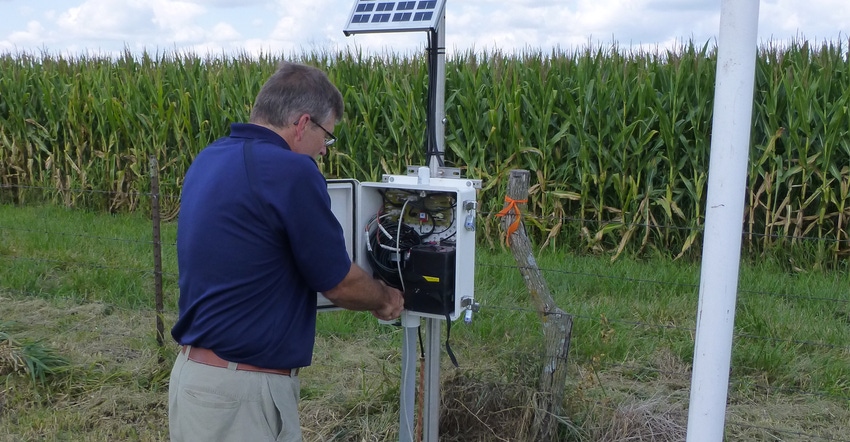May 1, 2019

By Jacqueline Stolze and Jamie Benning
As part of the Iowa Watershed Approach, the Iowa Flood Center has deployed a network of hydrologic stations that provides real-time weather information farmers and scientists can use for future flood forecasting and drought monitoring.
The IFC stations measure rainfall, wind speed and direction, and soil moisture and temperature. A shallow groundwater well also provides information about the water table. IFC makes all the data publicly available on the Iowa Flood Information System, an online tool that provides near real-time data on stream levels, flood alerts and forecasts, and weather conditions for the entire state. The IFC is a program based at the University of Iowa in Iowa City.
Expanded network
With funding from the Iowa Watershed Approach, IFC deployed a network of 20 of these hydrologic stations in 2018. These sensors represent an expansion of the IFC’s previous network of nearly 50 similar rain gauge stations statewide. This growing network of hydrologic stations is helping IFC reach its goal of deploying 100 stations in Iowa — roughly one in each county.
This network helps researchers and stakeholders better predict floods, assess droughts, and manage water resources. In addition, Iowa’s farmers can use the information to support their crop management systems and potentially boost yields.
For farmers, timely access to this kind of information is vital. Stewart and Jared Maas, a father-and-son team, farm about 1,800 acres 25 miles west of Iowa City. Their home farm is the site of one of the new IFC hydrologic stations.
“We try to do everything the right way,” Jared says, and data collected by the IFC hydro station can help. As Stewart and Jared prepare for spring fieldwork, they can check the online sensor data to learn when the soil is ready to plant, the best time for field applications, and how to plan for changing weather conditions.
Better data, better decisions
“It helps a lot,” Stewart says of the new weather monitoring system. One example is the timing of spring planting based on soil temperature and moisture. Farmers are encouraged to wait until soil temperatures reach 50 degrees F to begin planting and knowing soil moisture is important to reduce the impact to field operations on soil compaction.
Stewart and Jared now have facts on which to base their decisions — a real advantage for bigger farming operations like theirs. The data provide them peace of mind that they’re doing things “the right way.”
Stewart has been working with University of Iowa researchers for years, conducting on-farm trials. “The university has been really good to us here,” Stewart says. “I’ve got a lot of respect for the hydrology department.”
Originally, IIHR stood for the Iowa Institute of Hydraulic Research at the University of Iowa. In 2002, this name was officially changed to IIHR — Hydroscience & Engineering to better reflect the broad scope and modern multidisciplinary nature of the institute’s focus. The acronym “IIHR” has been retained to reflect the institute’s rich history and past century’s achievements.
Stolze is lead communications specialist for IIHR; Benning is manager of the Water Quality Program for Iowa State University Extension.
Source: IIHR and ISU are responsible for the information provided and is wholly owned by source. Informa Business Media and subsidiaries aren’t responsible for any content in this information asset.
You May Also Like




